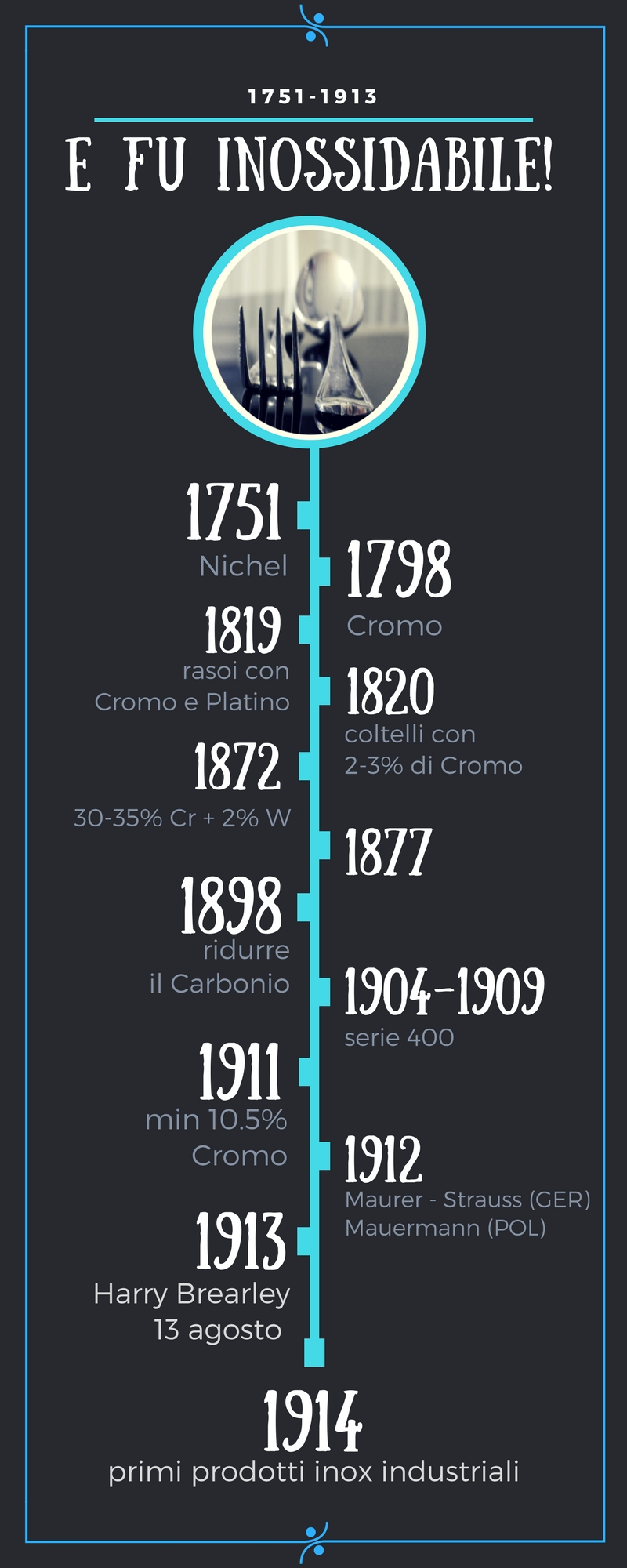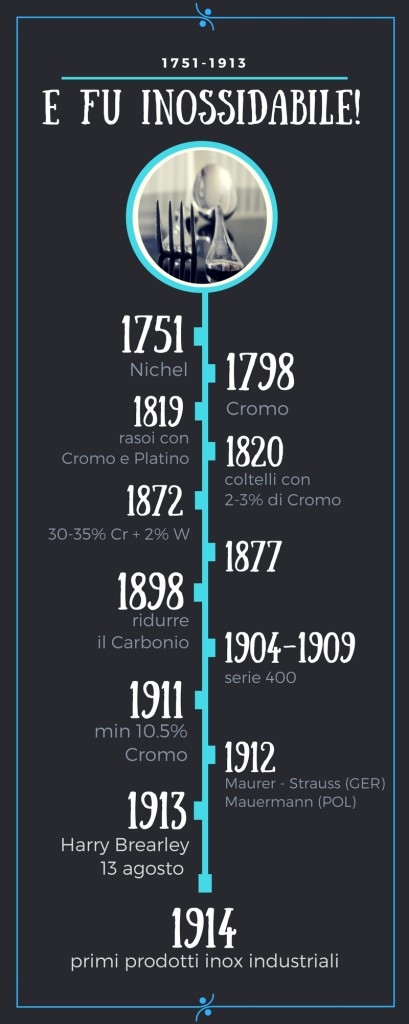Quando nel 1751 e nel 1798 Axel Cronsted, chimico e mineralogista svedese, e Louis Vauquelin, professore di chimica francese, scoprirono rispettivamente il Nichel e il Cromo, non potevano sapere di essere gli apripista di un nuovo percorso metallurgico che avrebbe cambiato il mondo. Certamente per arrivare alla meta sarebbero serviti molti anni e molti uomini di ingegno, piccoli passi in fila, sempre più rapidi e sicuri, ma la strada era stata tracciata.
Si procedette per tentativi ed errori, perché non fu subito chiaro il ruolo del Cromo e nemmeno le sue interazioni con il Carbonio! Il francese Pierre Berthier, per esempio, sebbene avesse iniziato a intuire la relazione tra il Cromo e l’inossidabilità, produsse nel 1820 coltelli artigianali che ne contenevano solo il 2-3%: un tenore troppo basso per superare i test di corrosione a cui i manufatti vennero sottoposti. L’anno precedente il geniale scienziato inglese Michael Faraday, con l’aiuto del collega James Stodart, aveva cercato di ovviare a quel problema unendo all’acciaio metalli come il Platino, il Rodio e l’Argento in concentrazioni vicine al 50%, mentre il Cromo restava intorno al 3%. Produssero così preziosi rasoi inossidabili di una lega troppo costosa perché potesse essere usata su larga scala.
Nel 1865 l’acciaio inossidabile era ancora un lontano miraggio, ma qualcuno riuscì comunque ad intuire le potenzialità di una lega meno soggetta al logoramento: il Signor Baur, fabbricante di Brooklyn, utilizzò le leghe Fe-Cr disponibili per costruire casseforti e barre per prigioni. Non tutti, però, furono così accorti, tanto che nel 1872 John Woods e John Clark, inglesi, ottennero un brevetto per una lega con concentrazione di Cromo al 30-35% e Tungsteno al 2% che rimase inutilizzata. Lo stesso accadde nel 1877 quando due industriali di Sheffield (UK), Henry Seebohm e Charles Dieckstahl produssero sperimentalmente una lega martensitica senza riuscire a capirne l’impiegabilità.
Sul volgere del secolo si fecero gli ultimi preparativi per il grande cambiamento: nel 1898, mentre i francesi Carnot e Goutal chiariscono la relazione tra il carbonio e l’ossidazione, viene messo a punto il processo Goldsmith, che consentì di creare leghe con un basso tenore di carbonio.
Piccole grandi occasioni andarono ancora perse con gli scienziati francesi Leon Guillet (1904) e Albert Marcel Portevin (1909) i quali, conducendo esperimenti su alcuni acciai ferritici della serie 400, non notarono l’inossidabilità delle leghe.
Dal 1911, anno in cui i tedeschi Philipp Monnartz e William Borchers fissarono al 10.5% il quantitativo minimo di Cromo utile a garantire l’inossidabilità, ci fu una vera e propria corsa per aggiudicarsi la scoperta del secolo. Ricordiamo, tra i tanti, gli americani Elwood Haynes (1911-1919), Frederick Becket e Christian Dantsizen (1911-1914); i tedeschi Eduard Maurer e Benno Strauss (1912-1914); il polacco Max Mauermann (1912-1913) e Harry Brearley, a Sheffield (UK).
A tagliare il traguardo, il 13 agosto 1913, fu Harry Brearley che in quella data definì la formula di un inossidabile martensitico con il 12.8% di Cromo e lo 0.24% di Carbonio e una settimana dopo avviò la prima colata di acciaio inossidabile. Mauermann in ottobre presentò la sua lega all’esibizione internazionale Adria a Vienna, ma Brearley stava già pensando a come industrializzare il suo inox. Quando gli americani e i tedeschi giunsero alla fine dei loro esperimenti, Brearley aveva già trovato un collaboratore, Ernest Stuart, e tra giugno e luglio del 1914 vide la luce il primo lotto industriale di coltelli inox.[1]
ENGLISH VERSION:
In 1751 and 1798 the swedish chemist Axel Cronsted and the chemical academic Louis Vauquelin, discovered Nickel and Chromium. Maybe they didn’t know to be forerunners of a new metallurgic path that would change the world. The finish line was far away, long time would be passed together with many smart men, ma it was a beginning.
The research went on trying and failing initially, because it was not already clear Chromium function and neither its interaction with Carbon.
The Frenchman Pierre Berthier, for example, even if he realized there was a relation between Chromium and reducing oxidation, in 1820 he produced artisan knives made with an alloy with only 2-3% of Chromium: a level too low to allow products passed corrosion tests. In 1819 the genial scientist Michael Faraday, helped by the colleague James Stodart, had already tried to resolve this problem not increasing Chromium but adding Platinum, Rhodium or Silver (q.ty: 50%). They obtained precious razors made with an expensive alloy unusable wholesale.
In 1865 the stainless steel was a mirage, yet, but someone could already see the potential of a corrosion resistant metal. It was a Brooklyn craftsman who firstly tried to turn new alloys into a business producing strongboxes and prison bars.
It couldn’t be said the same for John Woods and John Clark, Englishmen who obtained a temporary patent for their alloy with 30-35% of Chromium and 2% of Tungsten, but they didn’t used it. The same happened in 1877, when two industrialists of Sheffiled (UK) named Henry Seebohm and Charles Dieckstahl, produced an experimental alloy similar to the future Brearley’s one, but they didn’t understand the possibilities of application.
The great change came on the century end: in 1898 Carnot and Goutal from France explained the relation between Carbon and oxidation, in the while the Goldsmith Process for producing steel alloy with a low Carbon concentration was developed.
Anyway, there was other lost opportunities: Leon Guillet (1904) and Albert Portevin (1909), both French, didn’t notice the oxidation resistance of alloys “400 serie” they were studying.
In Germany Philipp Monnartz and William Borchers in 1911 agreed upon the minimal quantity of Chromium (10.5%) needed to grant oxidation resistance.
A lot of scientist tried to be awarded as inventor: Americans Elwood Haynes (1911-1919), Frederick Becket and Christian Dantsizen (1911-1914); Eduard Maurer and Benno Strauss from Germany (1912-1914); the Polish Max Mauermann (1912-1913) and Harry Brearley, from Sheffield (UK).
The worth of the invention has been recognized to Harry Brearley who on 13th august of 1913 found the right formula for a martensitic stainless steel (12.8% Chromium and 0.24% Carbon) and immediately worked to produce the first casting, aim that he reached in a week. During the Adria exposition in Vienna, October 1913, Mauermann presented his alloy, but Brearley was already thinking a way to industrialize the stainless steel. In 1914 many scientist succeed in finding their stainless steel version, but Brearley was helping his collaborator Ernest Stuart in producing the first stock of industrial inox knives. It was summer 1914 (June-July).
[1] Per questo articolo abbiamo utilizzato: 1913-2013. 100 years of Stainless Steel, Sheffield, a cura di Nancy Fielder per il giornale The Star, edito nel 2013; Enduro. Acciai Inossidabili, Fiat – Ferriere Piemontesi del 1955; The History of Stainless Steel, Harold M. Cobb, ASM International, 2010; 100 Years of Stainless Steel. The History of Stainless Steel, ISSF, 2016 [pdf]. Sono stati consultati, inoltre, i siti web delle associazioni SSINA (Specialty Steel Industry of North America) e BSSA (British Stainless Steel Association).



[…] Inox mentre stava cercando qualcosa di diverso e, come era accaduto ad altri prima di lui (si veda Insieme verso l’inossidabile: gli uomini di Mr. Inox, dal 1715 al 1913) non seppe fin da subito in cosa fosse fortunatamente […]